外研版七年级英语上册全部知识点
- 格式:docx
- 大小:23.20 KB
- 文档页数:13

七年级上英语外研知识点归纳总结一、单词和短语1. Greetings and Introductions (问候和介绍)- Hello! (你好!)- Hi! (嗨!)- Good morning/afternoon/evening! (早上/下午/晚上好!)- How are you? (你好吗?)- Nice to meet you! (很高兴见到你!)- What's your name? (你叫什么名字?)- My name is... (我叫…)2. Classroom Objects (教室用品)- Pen (钢笔)- Pencil (铅笔)- Book (书)- Desk (课桌)- Chair (椅子)- Eraser (橡皮擦)- Ruler (尺子)- Bag (书包)3. Numbers (数字)- Zero (零)- One (一)- Two (二)- Three (三)- Four (四)- Five (五)- Six (六)- Seven (七)- Eight (八)- Nine (九)- Ten (十)4. Days of the Week (星期) - Monday (星期一)- Tuesday (星期二)- Wednesday (星期三)- Thursday (星期四)- Friday (星期五)- Saturday (星期六)- Sunday (星期日)5. Family Members (家庭成员) - Mother (妈妈)- Father (爸爸)- Brother (哥哥/弟弟)- Sister (姐姐/妹妹)6. Colors (颜色)- Red (红色)- Blue (蓝色)- Yellow (黄色)- Green (绿色)- Orange (橙色)- Purple (紫色)- Black (黑色)- White (白色)二、语法知识点1. 一般现在时- 表示经常性或习惯性的动作或状态。

Module1Module2I.重点短语:I.重点短语:1.befrom...=comefrom...1.来自......1.aphotoofTony’sfamily1.一XTony的家庭的照片2....yearsold2.......岁2.ontheleftof.....2.在......的左边3.whatabout...=howabout...3.......怎么样?3.nextto.....3.紧挨着.....;紧靠......4.inClassTen,GradeSeven4.在七年级十班4.infrontof......4.在......前面〔分开〕5.thecapitalof...5......的首都/省会in/atthefrontof......在......前面〔没有分开〕6.firstname=givenname6.名5.Tony’sparents5.Tony的父母stname=familyname7.姓6.inthephoto6.照片上8.Englishname8.英文名字7.atthebusstation7.在公共车站9.Chinesename9.中文名字8.atapolicestation8.在警察局II.重点句子:9.amanagerofatheater9.一位剧院负责人1.I’mChinese,andI’mfrom1.我是中国人,我来自中国.=atheatermanagerChina.10.amanagerofahotel10.一位宾馆经理(I’mChinese,andIcome2.他们来自什么哪里?=ahotelmanagerfromChina.)11.at/inthesamehospital11.在同一家医院他们来自美国.2.Wherearetheyfrom?12.abusdriver12.一位公共汽车司机(=Wheredotheycome13.afarmworker13.一位农场工人from?)14.ashopworker14.一名店员TheyarefromAmerica.15.anEnglishteacher15.一位英语教师(=TheycomefromII.重点句子:America.)1.ThisisaphotoofTony’s1.这是Tony的一X全家福。

外研版七年级英语上册M1-10重点知识大全Module1 My classmates重要知识点讲解Unit 1一、be动词的用法[点拨]1.be动词有三种形式: am, is, are,都是“是”的意思。
be动词与不同人称搭配:我(I)用am,你(you)用are; is用于他(he)她(she)它(it);单数is,复数are。
2.be动词的否定形式表达肯定句改为否定句时,直接在be动词后加not构成。
He is a teacher.他是一名老师。
(肯定句)He is not a teacher.他不是一名教师。
(否定句)3.be动词的一般疑问句表达陈述句改为一般疑问句时直接将be动词提到主语之前构成。
He is a teacher.他是一名老师。
(肯定句)Is he a teacher.他是一名教师吗?(疑问句)肯定回答:Yes, he is.是的,他是。
否定回答:No, he isn’t.不,他不是。
二、询问对方来自哪里的句型-Where are you from? 你来自哪里?-I'm from Beijing.我来自北京。
[点拨]"Where + be + 主语+ from?"意为“...来自哪里/是哪里人?”,多用于询问国籍/籍贯。
回答为“主语+be from+地点”。
be from意为“来自”,其中的be动词要随主语人称和数的变化而变化。
三、用于确定对方国籍的句型-Hi, are you English too?嘿,你也是英国人吗?-No, I’m not. I’m American and my name is Betty King. 不,我不是。
我是美国人,我叫贝蒂·金。
[点拨]"Are you+国籍?"通常在没有把握确定对方国籍时用此句型。
该句是一般疑问句,肯定回答用“Yes,I am.”否定回答用“No,I'm not.”。

七年级上Revision of Starter 一、重点短语sit down坐下stand up站起来how old多大after school/class放学后/下课后listen to music听音乐welcome to+地点欢迎来某地in English用英语say that again再说一遍of course当然what color什么颜色eve,yday life每天的生活good idea好主意how many/how much多少thank you/thanks谢谢put up sb's hand举起某人的手telephone number电话号码write it on the blackboard把它写在黑板上play basketball/football打篮球/踢足球in Class Five Grade One在一年级五班see you tomorrow明天见go swimming去游泳m+国家/城市等在国家/城市等at+车站/学校/家等在车站/学校/家等sb's favorite sport/color某人最喜欢的运动/颜色good morning/afternoon/evening早上好/下午好/晚上好二、重点句型l---\邓at's your name, please? 请问你叫什么名字?---I'm/My mane's... 我叫.2.---How are you ? 你好吗?---F ine,thanks.很好,谢谢……..in spring/summer/autumn/winter在春/夏/秋/冬等3.---This is my friend/teacher, and his/her name is/he is...这是我的朋友/老师,他的名字是.4.---I t's time to go now. Goodbye.现在该走了,再见。

七年级上册英语外研社版知识点总结一、Unit 1 My new school1. 介绍自己的新学校及周围环境在这个单元中,我们学习了如何用英语介绍自己的新学校以及周围的环境。
我们学会了使用形容词和介词来描绘学校的外观和位置,为我们日常交流提供了基础词汇和句型。
2. 学习新的动词短语和日常用语在这个单元中,我们还学习了一些新的动词短语和日常用语,这些短语和用语可以帮助我们更流利地表达自己的想法和感受,使我们在英语交流中更加自信。
3. 表达自己的学校生活和喜好除了学校的介绍,我们还学会了表达自己的学校生活和喜好,这些内容涉及到动词的时态和一些常用的名词短语,帮助我们更好地展示自己的日常生活。
二、Unit 2 This is my sister1. 描述家庭成员和亲戚关系在这个单元中,我们学习了如何用英语描述家庭成员和亲戚关系,包括使用人称代词和家庭成员的称呼,让我们能够更好地向别人介绍自己的家庭。
2. 表达自己的爱好和特长我们还学习了如何用英语表达自己的爱好和特长,这些内容涉及到一些常见的动词和名词,为我们展示自己的个性提供了更多的表达方式。
3. 学习新的动词和形容词在这个单元中,我们也学习了一些新的动词和形容词,这些词汇可以帮助我们更准确地描述自己和家人,让我们的表达更加生动和有趣。
三、Unit 3 Is this your pencil?1. 学习和巩固物品的名称在这个单元中,我们学习了一些日常用品的英文名称,包括文具、衣物等,这些词汇是我们日常生活中必不可少的,掌握了这些词汇可以让我们在购物和交流中更加得心应手。
2. 学习特殊疑问句除了学习物品的名称,我们还学习了如何用特殊疑问句来询问别人是否拥有某样物品,这也为我们以后的交流提供了更多的句型结构。
3. 学习并掌握新的介词和代词在这个单元中,我们还学习了一些新的介词和代词,这些词汇的掌握可以让我们更准确地描述物品的位置和归属,提高我们的口语表达能力。

英语书外研版七年级上册一、重点单词。
1. Module 1.- to:介词,到……;向……。
如:Welcome to Beijing.- meet:动词,遇见;结识。
例如:Nice to meet you.2. Module 2.- this:指示代词,这;这个。
This is my book.- that:指示代词,那;那个。
That is his pen.- these:this的复数形式,这些。
These are my pencils.- those:that的复数形式,那些。
Those are her bags.二、重点语法。
1. be动词的用法。
- be动词(am/is/are)根据主语的不同而变化。
- I用am,例如:I am a student.- 第三人称单数(he/she/it等)用is,如:He is my father. She is a teacher. It is a cat.- 复数主语(we/you/they等)和第二人称(you)用are,例如:We are friends. You are a good boy. They are my classmates.2. 指示代词的用法。
- this和these用来指离说话人较近的人或事物;that和those用来指离说话人较远的人或事物。
- 在回答this/that的问句时,要用it代替;回答these/those的问句时,要用they代替。
例如:- What's this? It's a book.- What are those? They are pens.三、课文解析(以Module 1 Unit 1为例)1. 课文内容。
- “Hello, class. My name's Miss Zhou. Nice to meet you.”- 这是老师在课堂上的自我介绍,“Nice to meet you”是初次见面时常用的礼貌用语。
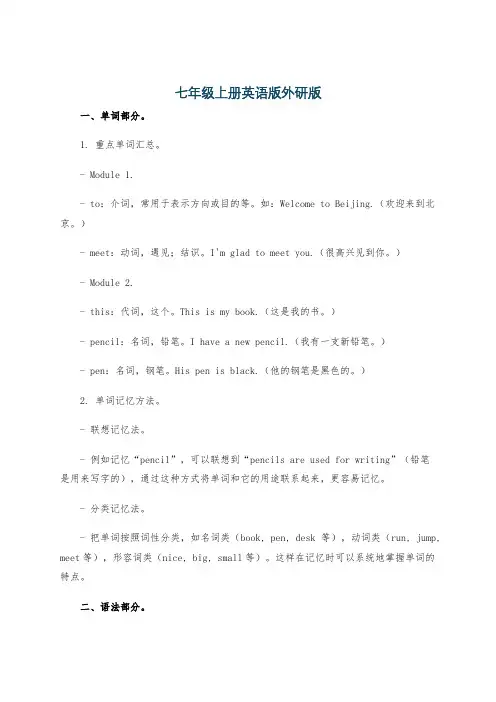
七年级上册英语版外研版一、单词部分。
1. 重点单词汇总。
- Module 1.- to:介词,常用于表示方向或目的等。
如:Welcome to Beijing.(欢迎来到北京。
)- meet:动词,遇见;结识。
I'm glad to meet you.(很高兴见到你。
)- Module 2.- this:代词,这个。
This is my book.(这是我的书。
)- pencil:名词,铅笔。
I have a new pencil.(我有一支新铅笔。
)- pen:名词,钢笔。
His pen is black.(他的钢笔是黑色的。
)2. 单词记忆方法。
- 联想记忆法。
- 例如记忆“pencil”,可以联想到“pencils are used for writing”(铅笔是用来写字的),通过这种方式将单词和它的用途联系起来,更容易记忆。
- 分类记忆法。
- 把单词按照词性分类,如名词类(book, pen, desk等),动词类(run, jump, meet等),形容词类(nice, big, small等)。
这样在记忆时可以系统地掌握单词的特点。
二、语法部分。
1. 一般现在时。
- 概念:表示经常发生的动作或存在的状态。
- 结构:- 主语为第三人称单数(he/she/it等)时,动词要用第三人称单数形式(一般在动词原形后加 -s或 -es)。
例如:He likes reading books.(他喜欢读书。
)- 主语为第一人称(I)、第二人称(you)和复数(we/they等)时,动词用原形。
如:We play football every day.(我们每天踢足球。
)- 用法:- 表示习惯性、经常性的动作。
例如:I get up at six o'clock every morning.(我每天早上六点起床。
)- 表示客观事实或真理。
The earth goes around the sun.(地球绕着太阳转。
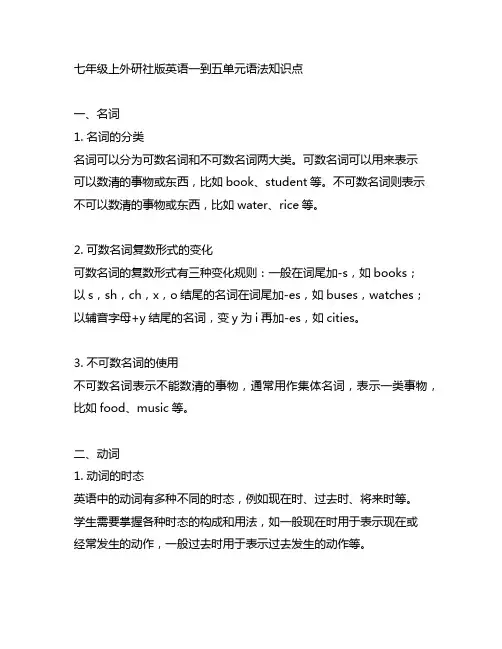
七年级上外研社版英语一到五单元语法知识点一、名词1. 名词的分类名词可以分为可数名词和不可数名词两大类。
可数名词可以用来表示可以数清的事物或东西,比如book、student等。
不可数名词则表示不可以数清的事物或东西,比如water、rice等。
2. 可数名词复数形式的变化可数名词的复数形式有三种变化规则:一般在词尾加-s,如books;以s,sh,ch,x,o结尾的名词在词尾加-es,如buses,watches;以辅音字母+y结尾的名词,变y为i再加-es,如cities。
3. 不可数名词的使用不可数名词表示不能数清的事物,通常用作集体名词,表示一类事物,比如food、music等。
二、动词1. 动词的时态英语中的动词有多种不同的时态,例如现在时、过去时、将来时等。
学生需要掌握各种时态的构成和用法,如一般现在时用于表示现在或经常发生的动作,一般过去时用于表示过去发生的动作等。
2. 动词的否定形式英语中的动词否定形式通常在动词前加not构成,例如I am not happy。
3. 动词的被动语态动词的被动语态表示动作的承受者是谁,被动语态的构成是由“be + 过去分词”构成,如The book is read by me.三、形容词与副词1. 形容词的比较级与最高级形容词的比较级和最高级构成规则较多,主要包括一般形容词和部分双音节形容词的比较级在词尾加-er,最高级在词尾加-est;以不规则变化的形容词则需特殊学习,如good-better-best。
2. 副词的用法副词主要用来修饰动词、形容词或其他副词,表示程度、时间、地点或方式等。
学生需要掌握副词的用法和位置,如修饰动词时通常位于动词之前,修饰形容词或副词时通常位于其后。
四、介词1. 介词的用法介词用来表示名词或代词与其他词之间的关系,如位置、方向、时间、原因等。
学生需要掌握各种介词的用法,如in表示在……之内,on表示在……之上等。
2. 介词短语的用法介词短语是构成形式固定的词组,由介词和名词、代词或动名词构成。
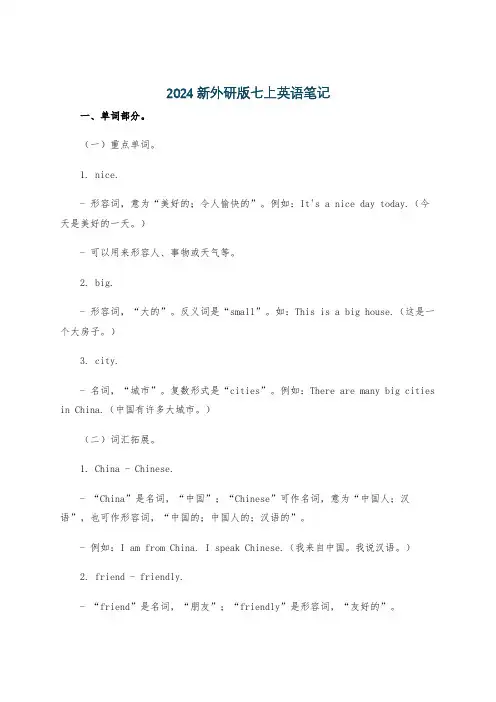
2024新外研版七上英语笔记一、单词部分。
(一)重点单词。
1. nice.- 形容词,意为“美好的;令人愉快的”。
例如:It's a nice day today.(今天是美好的一天。
)- 可以用来形容人、事物或天气等。
2. big.- 形容词,“大的”。
反义词是“small”。
如:This is a big house.(这是一个大房子。
)3. city.- 名词,“城市”。
复数形式是“cities”。
例如:There are many big cities in China.(中国有许多大城市。
)(二)词汇拓展。
1. China - Chinese.- “China”是名词,“中国”;“Chinese”可作名词,意为“中国人;汉语”,也可作形容词,“中国的;中国人的;汉语的”。
- 例如:I am from China. I speak Chinese.(我来自中国。
我说汉语。
)2. friend - friendly.- “friend”是名词,“朋友”;“friendly”是形容词,“友好的”。
- 如:He is my friend. He is very friendly.(他是我的朋友。
他非常友好。
)二、短语部分。
(一)常用短语。
1. be from.- 意为“来自……”,相当于“come from”。
- 例如:I am from Beijing. = I come from Beijing.(我来自北京。
)2. a photo of.- “……的一张照片”。
- 如:This is a photo of my family.(这是我的一张家庭照片。
)三、语法部分。
(一)一般现在时。
1. 概念。
- 表示经常发生的动作或存在的状态。
- 例如:I get up at six every day.(我每天六点起床。
)2. 动词形式。
- 当主语是第三人称单数(he/she/it等)时,动词要加 -s或 -es。
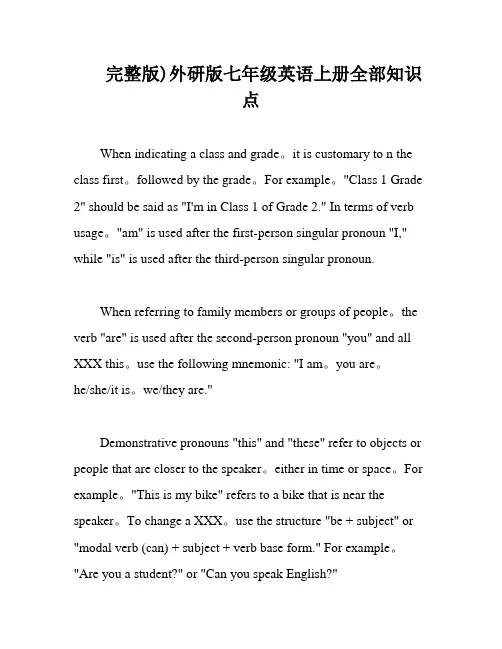
完整版)外研版七年级英语上册全部知识点When indicating a class and grade。
it is customary to n the class first。
followed by the grade。
For example。
"Class 1 Grade 2" should be said as "I'm in Class 1 of Grade 2." In terms of verb usage。
"am" is used after the first-person singular pronoun "I," while "is" is used after the third-person singular pronoun.When referring to family members or groups of people。
the verb "are" is used after the second-person pronoun "you" and all XXX this。
use the following mnemonic: "I am。
you are。
he/she/it is。
we/they are."Demonstrative pronouns "this" and "these" refer to objects or people that are closer to the speaker。
either in time or space。
For example。
"This is my bike" refers to a bike that is near the speaker。
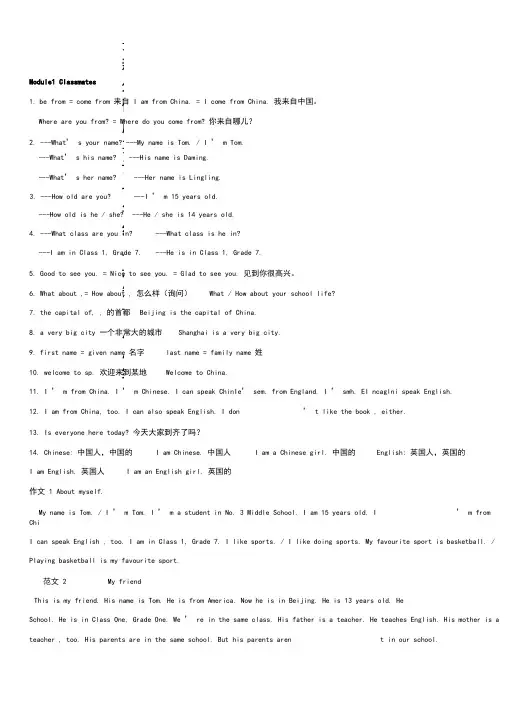
Module1 Classmates1. be from = come from 来自 I am from China. = I come from China. 我来自中国。
Where are you from? = Where do you come from? 你来自哪儿?2. ---What ’ s your name? ---My name is Tom. / I ’ m Tom.---How old is he / she? ---He / she is 14 years old. 4. ---What class are you in?---What class is he in? ---I am in Class 1, Grade 7. ---He is in Class 1, Grade 7.5. Good to see you. = Nice to see you. = Glad to see you. 见到你很高兴。
6. What about ,= How about , 怎么样(询问) What / How about your school life?7. the capital of, , 的首都 Beijing is the capital of China.8. a very big city 一个非常大的城市 Shanghai is a very big city.9. first name = given name 名字 last name = family name 姓 10. welcome to sp. 欢迎来到某地 Welcome to China.11. I ’ m from China. I ’ m Chinese. I can speak ChinIe ’ sem. from England. I ’ smh. EI ncaglni speak English. 12. I am from China, too. I can also speak English. I don ’ t like the book , either.13. Is everyone here today? 今天大家到齐了吗? 14. Chinese: 中国人,中国的 I am Chinese. 中国人I am a Chinese girl. 中国的English: 英国人,英国的I am English. 英国人I am an English girl. 英国的作文 1 About myself.My name is Tom. / I ’ m Tom. I ’ m a student in No. 3 Middle School. I am 15 years old. I ’ m fromChiI can speak English , too. I am in Class 1, Grade 7. I like sports. / I like doing sports. My favourite sport is basketball. / Playing basketball is my favourite sport.范文 2 My friendThis is my friend. His name is Tom. He is from America. Now he is in Beijing. He is 13 years old. HeSchool. He is in Class One, Grade One. We ’ re in the same class. His father is a teacher. He teaches English. His mother is a teacher , too. His parents are in the same school. But his parents aren最新外研版英语七年级上册知识点总结 ---What ’ s his name? ---His name is Daming. ---What ’ s her name?---Her name is Lingling. 3. ---How old are you? ---I ’ m 15 years old. t in our school.Module2 My family Vocabulary:A family: father - mother dad (daddy) — mum ( mom) / mummy parent -parents uncle —aunt brother—sister son—daughter husband—wife man -- woman boy - girl grandfather - - grandmother grandpa 丁grandma grandparent -grandparents cousinB job: a driver, a farmer, a worker, a manager, a teacher, a student, a doctor, a nurse, a singer, a writer, an actor, an actress, a policeman, policewoman,C place: at a bus station, in a hospital, in a hotel, at a theatre, on a farm, at school, in the shop, in a factory1.I have an elder brother. 哥哥She has a younger / little sister. 妹妹2.This is a photo of my family. 一张我的全家福My family is a big one. 家庭This is Jim ' s family tree谱My family are watching TV now. 家人3.on the left在左边on the right在右边on the left / right of 在…的左边/右边4.next to 在•・旁边,紧挨着=beside = near5.in front of 在…前面 (相对独立) in the front of 在“前部(在…内部) There is a tree in front of the house. There is ablackboard in the front of the classroom.6.at the bus station 在公共汽车站at school 在学校at the same hospital 在同一所医院at a police station 在警局7.(be) in hospital (生病)住院in the hospital 在医院Tom is ill in hospital because he is ill. Tom’ s father works in the hospital.8.in the photo 照片上There is a big house in the photo.9.a manager of a theater = a theater manager 一个剧院经理10.a manager of a hotel = a hotel manager 一个旅馆经理11.a bus driver 一位公共汽车司机 a farm worker 一位农场工人 a shop worker 一名店员an English teacher 一位英语老师12.man - woman (men - women) a woman doctor - women doctors 女医生 a man teacher — men teachers 男老There are three men teachers in the office.13.Is this / that your family? f Yes, it is./ No, it isn ' t.Are these / those your parents? f Yes, they are. / No, they aren ' t.14.Who is this? Who is this boy?Who are the boy and the girl? They are my friends.15.问职业:What is your mother? = What does your mother do? = What is your mother What be + sjob?(主语)? Whatdo / does + 主语+do? What be one ’ s job?16.介绍家庭常用的句型。
初一英语外研版知识点七年级上册英语知识点1、Unit 1 ——Unit 21)问候语:Good morning/ afternoon/ evening.How are you?---Just OK, thank you. How are you?---Not bad, thanks.Hi! Hello!How do you do?2)道别用语:Nice/ Glad to meet/ see you.(meet用于初次见面,see用于熟人间)Nice to meet/ see you, too.Goodbye. Byebye. Bye. See you (later/ tomorrow/ next time)! So long! Good night!3)介绍人或者物的句型:This is...4)Excuse me.与I'm sorry.的区别:Excuse me.是要引起对方的注意,而I'm sorry.则是向对方道歉。
5)词组be from = come fromin English6)当问句中问到this/ that时,回答要用it;问到these/ those时,要用they来回答。
例如: What's this in English?----It's an eraser.What are those?----They are books.7)对Thanks.的回答:That's OK./ You're welcome./ My pleasur.8)look the same = have the same looksgive sth. to sb. = give sb. sth.be like = look likein the tree/ on the tree (树上结的、长出来的用on,否则用in)in red(穿着红色的衣服)in the desk(在空间范围之内)in English(用英语)help sb. do sth.初一年级英语下册复习资料基数词的部分用法1、表顺序。
外研版初一上册英语重点知识
1.人称及人称代词的不同形式:学生需要掌握主格和宾格的人称
代词,例如I/me, you/you, he/him等。
2.基数词:这是表示数量的词,相当于代数里的自然数,例如zero,
one, two等。
3.一般疑问句及特殊疑问句:学生需要学会如何构造和回答这两
种类型的疑问句。
4.可数名词变复数:英语中的名词有单数和复数形式,学生需要
掌握可数名词如何变为复数形式,特别是以o结尾的词,有的加“-s”,有的加“-es”。
5.常用单词和短语:学生需要熟悉一些常用的单词和短语,以便
能够理解和使用英语进行日常交流。
6.基本语法:包括句子的结构、时态、语态等基本的语法知识。
7.阅读和写作技能:通过阅读和写作练习,提高学生的英语阅读
和写作能力。
8.听力和口语技能:通过听力和口语练习,提高学生的英语听力
和口语能力。
七年级(上)Module1 My classmates1.系动词be的用法:am用于第一人称I后; is用于第三人称单数后; are用于第二人称you及各种人称复数后。
口诀:I是am you是are is 用于he, she, it,复数形式全用are 。
2. 陈述句变一般疑问句的句式:(1)be+主语 +...... eg: Are you a student?(2)情态动词(can)+ 主语+ 动词原形+……eg: Can you speak English?(3)助动词(do, does, did)+ 主语+ 动词原形+...... Eg: Do you like English?3. 代词(1)人称代词:主格: I we you you he she it they ( 做主语 )宾格:me us you you him her it them ( 作宾语/表语 )(2)物主代词:形容词性物主代词: my our your your his her its their (做定语)名词性物主代词:mine ours yours yours his hers its theirs (作定语以外成分)名词性物主代词=形容词性物主代词+名词eg: mine = my book语言点解析1.Chinese n. 汉语;中国人adj. 中国的,中国人的(1)作“语文,汉语”讲时,为不可数名词。
作“中国人”讲时,为可数名词,单复数形式相同。
Eg: He can speak a little English.We are all Chinese. 我们都是中国人。
(2)作为“中国的,中国人的”讲时,为形容词。
I’m a Chinese student. 我是一名中国的学生。
2. What about/ How about…的用法(1)What about you = How about you 用来询问对方或第三者对前面所讨论话题的看法。
(2) What about = How about +n./pron./v-ing 表示“怎么样”用来提出建议或请求。
Eg: How about listening to some music?听点音乐怎么样呢?How about some apples? 吃些苹果怎么样?3. Nice to meet you! = It’s nice to meet you!Glad to meet you! = I’m glad to meet you!4.welcome v. 欢迎 Adj. 受欢迎的(1)“欢迎” welcome sb. to...“欢迎某人到......”eg. Welcome you to China. 欢迎你来到中国。
(2)用作答谢的客套话,表示“不客气”eg.—Thank you! 谢谢你!—You are welcome! 不客气!5.在英语中,英美名字在前,姓在后first name = give name 名字last name = family name 姓1.too adv. 也;太(1)表示“也”,常放在肯定句句尾,表示某情况也适合某人。
句尾常用逗号隔开。
(2)表示“太”,修饰形容词或副词的原级。
Eg: The room is too big. 这个房间太小了。
2.表示某年级班级时,先说班级再说年级,class 和 grade 首字母大写。
eg: I’m Class 1 Grade 2. 我在二年级一班。
Module 2 My family1. 指示代词(1) this / these 意为“这个;这些”,表示在时间或空间上离说话人较近的人或物。
Eg: This is my bike. 这是我的自行车。
These bikes are mine. 这些自行车是我的。
(2)that /those意为“那个;那些”,表示在时间或空间上离说话人较远的人或物。
Eg: That is his book. 那是他的书。
Those books are his. 那些书是他的。
2. 名词所有格构成: (1) 在名词后加“’s”,(常用于有生命的名词)。
Eg: These are Tom’s books. 这些是汤姆的书。
(2) 在名词前加“of ”(常用于无生命的名词)。
Eg: I like the colour of the desk. 我喜欢这个桌子的颜色。
※ (a) 以字母s结尾的单数名词或复数名词,在词尾直接加”’”,不加s.Eg: This is Thomas’ room. 这是托马斯的房间These are the students’ books. 这些是学生们的书。
(b) 不以s结尾的复数名词,在词尾加“’s ”。
Eg:Today is Children’s Day. 今天是儿童节。
(c) 表示两者或两者以上共同拥有时,只在最后一个名词后用所有格。
但表示两者或两者以上分别拥有时,在名词后分别使用所有格。
Eg: This is Jim and Tom’s book. 这是吉姆和汤姆共有的书。
These are Jim’s and Tom’s desks 这些分别是吉姆和汤姆的书。
(d) 当“’s”所有格和of所有格结构一起使用时,叫做“双重所有格”。
其构成有两种形式:of + 名词所有格 of + 名词性物主代词Eg: He is a friend of my father’s. 他是我爸爸的一个朋友。
She is a friend of mine. 她是我的一个朋友。
(e) “’s”所有格后面常省略表示地点、场所的词。
Eg: He often goes to his uncle’s. 他经常去他叔叔家。
交际用语1. 确认人物的句型:_Is this your mum? 这是你的妈妈吗?_Yes, it is./ It isn’t. 是的,它是。
/不,它不是。
_Are these your parents? 这些是你的父母吗?_Yes, they are. /No they aren’t. 是的,他们是。
/不,他们不是。
2. 询问某人是谁的句型:_Who’s the girl in red? 穿红衣服的女孩是谁?_She is my friend. 她是我的朋友。
_Who is the boy on the left? 左边的那个男孩是谁?_He is my brother. 他是我的哥哥。
3. 表示位置关系的句型:_My mum is on the left/on the right. 我妈妈在左边/右边。
_Her husband sits next to her. 她的丈夫坐在她旁边。
_I’m in front of Li Lei. 我在李磊的前边。
4. 询问某人职业的句型:_What’s your father?/ What’s your father’s job? 你父亲是干什么的?_My father /He is a doctor. 我的父亲是一名医生。
_What do you do? 你是干什么的?_I’m a teacher. 我是一名老师。
_Who is the girl? 那个女孩是谁?_She is my sister. 她是我姐姐。
5. 表示某人职业的句型:My father is a manager. 我的父亲是一名经理。
Her mother is a nurse. 她的妈妈是一名护士。
I’m a teacher. 我是一名老师。
语言点解析1. fimaly n. 家; 家庭(成员) 集合名词。
作“家,家庭整体”讲,做主语时,谓语动词用单数形式。
作“家人,家庭成员”讲,做主语时,谓语动词用复数形式。
eg. (1) My fimaly is a big one. 我家是个大家庭。
(2) My fimaly are watching TV. 我的家人在看电视。
2. woman n. 成年女子,妇女( pl.) women Man n. 成年男子,男人 ( pl.) men 当man 和woman 作定语修饰后面的名词,要随着后面名词的复数而变复数。
eg. three women teachers 三名女教师two men doctors 两名男医生 4. what, how 引导感叹句的用法:(1)what 修饰名词或代词,在句中作定语。
What + a/an + adj. + 单数名词+主语+谓语。
What a tall building it is!它是一个多么高的楼啊!What+ adj.+ 复数名词/不可数名词+主语+谓语。
What interesting stories they are. 它们是多么有趣的故事啊!(2)how 修饰形容词和副词,在句中作状语。
How + adj./adv. + 主语 + 谓语。
eg. What nice weather it is. 多么好的天气啊!How interesting the book is.这本书是多么有趣啊! How hard they are studying. 他们正在多么努力地学习啊!5. in front of 与in the front of(1)in front of 在...(某物体范围外)的前面。
eg. The school is in front of my home. 学校在我家的前面。
(2)in the front of 在...(某物体范围内)的前面。
eg. The blackboard is in the front of my classrom. 黑板在教室的前面。
※ 表示方位的词归纳:behind 在….后面 beside 在---旁边 on the left ( right ) of … 在…左(右)边 next to 在---旁边,紧挨着 on the left 在左边 on the right 在右边6.go to hospital 去医院看病go to the hospital 去医院(不一定是病人) be in hospital 生病住院be in the hospital 在医院里(不一定是病人)7. police n. 集合名词,表示警察(总称),单复数同形。
前面一般要用定冠词the,作主语时,谓语动词用复数形式。
eg. The police are looking for the lost boy.警察正在寻找那个丢失的男孩。
8. job与work(1) job是可数名词, 意为“工作”;eg. My father has a job in a factory. 我的父亲在一(2) work作名词,意为“工作”,是不可数名词;作动词,意为“工作”,是不及物动词。